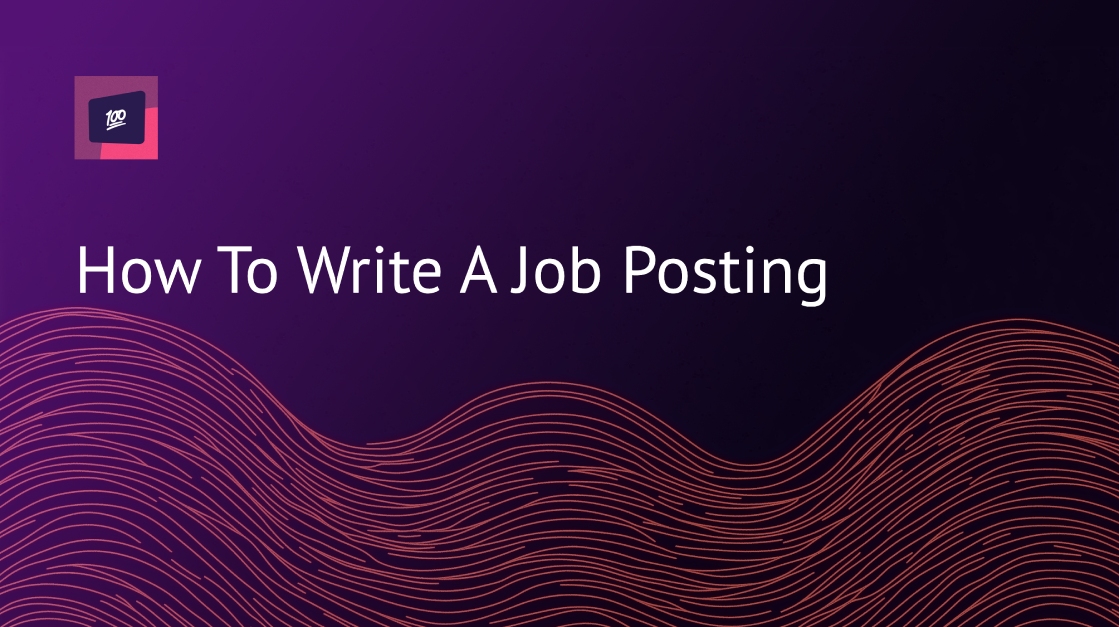How To Write A Job Posting

Are you interested in learning how to write an effective job posting?
Then you’re in the right place.
the best candidates faster



A carefully crafted job posting is vital if you hope to attract top talent to your business.
But when writing your job postings, a cookie-cutter approach isn’t going to cut it (no pun intended!). Every job posting must be well thought out and tailored. It must also be clear, concise, and engaging.
After all, this is your chance to introduce your company to potential employees and persuade them to submit an application.
Now, we know that’s a lot to think about, especially for busy professionals trying to juggle multiple open positions.
But the good news is, we can help. In this guide, we’re going to talk you through the most important aspects of a job posting, offering our top tips and advice on how to create job descriptions that will make your company stand out.
Read on to find out how.
Conduct a thorough job analysis
The best way to create an effective job posting is to break it down into different sections; that way, you can tailor each section to the specific role and goal you have in mind. But in order to do this, you first need to conduct a thorough job analysis and make some notes.
To do this, you should review the current salary structure within your organization and see how this compares to the current market. You should also look at job postings for similar roles to get a better feel for job titles, salaries, benefits, etc. This will give you a greater idea of what you’re up against and whether your job offer is competitive enough.
It’s also a good idea to make some detailed notes about what you want from the ideal candidate; write out the skills, experience, educational background, and qualifications you’d like them to have.
Think about the structure
You can now start thinking about the structure of your job posting. Most job postings will follow a similar format, making it easy for you to go through and tailor each section for different roles. A strong job posting structure will look something like this:
• Title
• Location, salary, and working hours
• Introduction to the job opportunity
• Bullet points outlining the key responsibilities
• A bit about the company
• Perks and benefits
• Requirements and qualifications
• Closing paragraph outlining the next steps and application process
Start with the job title
When you’re ready to get writing, the best place to start is the job title.
You need your job title to be direct and specific. This might sound basic, but in recent years lots of organizations have tried to be creative with their job titles. This can actually result in a vague or confusing title that stops professionals from applying to your position.
For example, trying to be unique using titles like ‘retail jedi’ instead of shop assistant or ‘flavor mixologist’ instead of bartender.
The wrong title could cost you time, money, and talented candidates, so think of something clear, concise, and to the point.
Describe the job opportunity
Those looking for a new career need a compelling reason to apply to your job posting. So, the next important step is describing the job opportunity.
You want your description to help the candidate visualize a typical day in the role. It needs to reflect exactly what they’ll be doing at your company, so avoid using generic job descriptions as a template. To help you with the job description, you should:
• Include the exact location of the job, giving the name of the town or city they’ll be working in
• Also, be sure to include the salary wherever possible. This is because over two-thirds (67%) of job hunters say the salary is the most critical part of a job posting and would influence whether they apply or not
• Include details about working hours and what type of role this is, for example, part-time, full-time, etc.
• Open with a short but attention-grabbing summary
• Provide an overview of the position and where the role would sit within the organization
• Hook the reader in by including a few details about your company and what makes it great
• Give details of the main responsibilities; bullet points can help to structure this information and make it easier to digest
Describe your company and its mission, vision, and values
This is your chance to showcase your company to candidates and convince them that they want to work for you. Once you’ve outlined the role, it’s time to give a brief overview of your company, what makes it so great, and any benefits or perks that are on offer. For example, how many days holiday will they get? Do you offer healthcare, mental well-being support, childcare, etc.?
As you don’t have a lot of space to write out all the reasons why working at your organization is the best, you can also use this opportunity to include a link to your company website. On the website, you could have a careers page or an about us page that shares the history of the company and your missions, visions, and values.
Candidates want to work for companies whose values reflect their own, so including them in one way or another can be a huge bonus and could increase the number of applications you receive.
Set out the requirements
The next thing you need to do on your job posting is to set out the requirements for the role. Being as specific as possible at this stage will help you to secure only the most relevant job applications. This can save you a lot of time scanning through resumes and turning down unqualified candidates. If you're hiring a data security specialist, specifying enhanced data protection requirements in your job posting is essential to ensure that you attract the right candidates
Set out the qualifications and experience you’re looking for, listing any specific qualifications or certificates you want the ideal candidate to have. You should also list some of the key skills and top qualities you’re looking for.
It’s important to be very clear about which of your requirements are absolutely necessary and which are just preferable to have.
Set out the next steps
The final stage of your job posting is to set out the application process. This might be submitting an application through a job site or sending over a resume and cover letter to a specified email address. You could also add a rough idea of how long it will take for successful candidates to hear back from you. For example, ‘successful candidates will hear back from us within three working days’.
Don’t make your job posting too long
You don’t want your job posting to be too long, as this can be very off-putting for candidates. On the other hand, you don’t want it to be too short as this suggests it doesn’t contain the important details.
Now, your job postings may differ in length depending on how much information you need to include, but as a general rule, it’s best to stick between 300 to 700 words. This is the optimal size, and anything over 700 words is likely to cost you potentially great applicants.
Plus, when structuring your job posting, it helps to use smaller blocks of text, headings, sub-headings, and bullet points to help organize the information. This can make it much easier for the job hunter to scan through and pick out the important details they need to know.
Check, check, and check again
Before submitting your job posting online, you need to make sure that it is perfect. If it is confusing, the information is wrong, or it is littered with spelling mistakes and grammatical errors, this isn’t going to look very professional.
So before you hit send, have at least one of your co-workers check it over; better still, if you can get several people to look it over. You should also give it a proofread yourself, checking it two or three times before publishing.
Know where to post your job
The internet has opened us up to a whole range of platforms and tools for finding and sharing job postings. From job boards to social media, there are lots of ways candidates can access this information, but you need to know where it is best to target your audience.
Generic job boards are often the starting place, or you can use your own careers page on your website. After this, think about sharing your vacancy on your company’s social media channels and LinkedIn.
If you’re looking for more skilled or specialized roles, you should also consider industry-specific job boards. In the search for a mobile app developer you can ensure a more targeted and effective recruitment process by considering dedicated platforms that focus on technology and app development. These can help you to target the right people and see results much quicker.
And don’t forget, you don’t just have to share it in one place; you can share it on multiple platforms, increasing your chances of finding the right candidates.
Final thoughts
If you’re currently recruiting and you’re hoping to cut down on the costs of hiring, as well as the time-to-hire, your job posting is the best place to start.
Whether it’s one vacancy or 30, following our step-by-step guide above can help you to create clear, concise, and detailed descriptions that are going to secure you more applications.
As we said earlier, your job posting acts as your introduction to candidates. This is your chance to grab their attention and show them that your business is the place to work. Get this wrong, and you could be losing out on potentially great hires.
So don’t rush. Use our tips and put some careful thought into each and every job posting you submit. It will be worth it in the long run.
the best candidates faster




